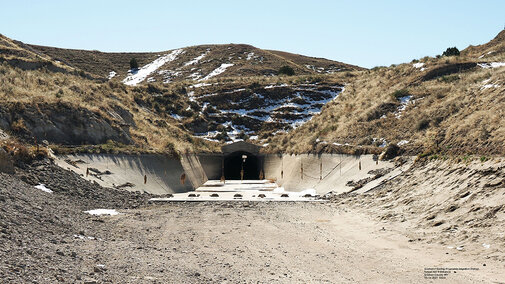The Gering-Fort Laramie Irrigation District held a public meeting Feb. 9 at the Panhandle Research and Extension Center to inform the district’s landowners, stakeholders and water users of the options being considered to repair or replace Tunnels No. 1 and 2, both in Wyoming on the main line canal of the Goshen/Gering-Fort Laramie main line canal; and seek input on what option the district should pursue.
HDR Engineering will present the same program to the Goshen Irrigation District landowners, stakeholders and irrigators. Both irrigation districts will then hold a joint meeting to determine which of the options they will pursue.

Representatives of HDR Engineering outlined the process and evaluation criteria used to determine which options were viable. The evaluation criteria consisted of public safety, operation and maintenance, constructability, risk and consequence of failure, hydraulic capacity and ability to expand, and permitting and compliance. The six options explored for Tunnels No. 1 and No. 2 are:
- Tunnel Repair — Steel Liner. Installing a fabricated steel liner in sections continuously the length of the tunnels using butt-welded joints. A consistent packing grout layer between the existing tunnel walls and the steel liner would also be installed. The tunnel diameter would be reduced, resulting with a loss of carrying capacity for irrigation water. Estimated cost for both tunnels at this time is $29,540,000 to $63,300,000.
- Tunnel Repair — Carbon Fiber Reinforced Polymer. Installing a carbon fiber reinforced polymer (CFRP) wrap against the existing concrete wall and saturated with an epoxy adhesive. The tunnel diameter would be reduced, resulting with a loss of carrying capacity for irrigation water. Estimated cost for both tunnels at this time is $42,840,000 to $91,800,000.
- Tunnel Replacement — Sequential Excavation Method (SEM) — existing location. Excavate the existing tunnels and re-line the tunnels to an effective diameter of 16 feet. Increased diameter would allow for greater water flow during critical water delivery periods and as a safety factor for storm water runoff into the canal. Estimated cost for both tunnels at this time is $25,031,200 to $53,638,200.
- Tunnel Replacement — Sequential Excavation Method (SEM) — new alignment/new tunnel locations. Excavate short sections of a new tunnel ahead of new tunnel wall construction. Tunnel diameter could vary depending on uncertain subsurface conditions and construction costs. Estimated cost for both tunnels at this time is $34,648,600 to $74,247,000.
- Tunnel Replacement — Open Cut. This would be excavating the soil above the tunnel down to the existing tunnel, then demolishing the existing tunnel structures and constructing a concrete lined channel at the excavation base. Land acquisition and cultural features would need to be considered. Excavation slopes would be permanent. Estimated cost for both tunnels at this time is $37,586,500 to $80,542,300.
- Tunnel Replacement — Cut and Cover. This would be excavating the soil above the tunnel down to the existing tunnel, then demolishing the existing tunnel structures. A new tunnel would be constructed at the excavation base, probably using pre-cast concrete or cast-in-place concrete box culverts. This option considers using a 20-foot by 18-foot box culvert section with 2-foot-thick walls and a 4-foot-thick base. The excavation slopes would be much steeper and less material would be moved because the excavated material would be replaced over the new tunnels. Estimated cost for both tunnels at this time is $106,340,700 to $227,872,900.
After all the evaluation criteria was considered, the engineering firm proposed the irrigation districts consider options three, four and five. Options one and two were not considered viable because both would reduce the amount of water flow through the tunnels. Option six was not considered viable because it was cost prohibitive.
Once the option has been determined by both irrigation districts, there is still much more to be done. There are cultural considerations that must be observed — the Oregon Trail crosses over one of the tunnels, and there is a pioneer grave site near the entrance of Tunnel No 1. Some of the ground is owned privately, while other ground is either state or federally owned. There are several underground pipelines over one of the tunnels that would need to be addressed. Environmental/NEPA assessments and permits must be done and approved. Numerous state and federal agencies must be consulted, and approval obtained. Funding must be obtained and finalized.
Depending on which option is selected, the assessment and permitting process could take up to six years or more, according to HDR. Optimistically, if all the assessments, permitting, approval, and any land acquisitions fell into place, work on the tunnels could start the fall of 2023, once the 2023 irrigation season was over and no water in the canal. Work on the tunnels would be during the offseason for water deliveries, with any construction to be completed prior to the next water delivery season.
After the collapse of Tunnel No. 2 on the Goshen/Gering-Ft Laramie main canal in July 2019, temporary repairs were made to Tunnels No. 1 and 2. Steel “ribs” were installed inside the tunnels to give support to the concrete tunnel walls. Installation of these ribs restricted water flow to 80-85% of capacity of the tunnel in 2020.
During the winter of 2020-21, metal sheeting was installed over the ribs to increase water flow through the tunnels. This increased the water flow through the tunnels to 97% of capacity for the 2021 growing season.

